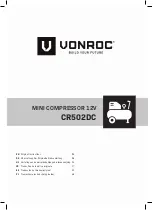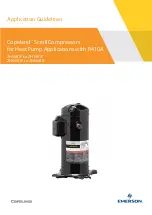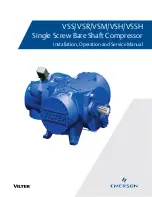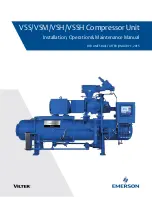
7.2 Fitting the supporting feet (8)
Fit the supplied supporting feet as shown in
Figure 6.
7.3 Fitting the air filters (15)
Remove the transportation stopper (B) and
screw the air filters (15) securely to the
equipment (Fig. 7, 8). Make sure that the intake
opening on the air filter faces down.
7.4 Changing the transportation cover (A)
Remove the transportation cover from the oil
filler opening (21) and insert the supplied oil
sealing plug (16) into the oil filler opening. (Fig.
9, 10.)
7.5 Mains connection
■
The compressor is equipped with a mains
cable with shock-proof plug. This can be
connected to any 230V ~ 50 Hz shock-proof
socket which is protected by a 16 A fuse.
■
Before you use the machine, make sure that
the mains voltage is the same as the
operating voltage (see the rating plate).
■
Long supply cables, extensions, cable reels
etc. cause a drop in voltage and can
impede motor start-up.
■
At low temperatures below +5°C,
sluggishness may make starting difficult or
impossible.
7.6 ON/OFF switch (Fig. 2)
Pull the ON/OFF switch (17) upwards to switch
on the compressor. To switch off the
compressor, press the ON/OFF switch down.
7.7 Setting the pressure (Fig. 1-3)
■
Use the pressure regulator (3) to set the
pressure on the pressure gauge (5).
■
The set pressure can be drawn from the
quick-lock coupling (4).
■
The vessel pressure can be read off the
pressure gauge (14).
■
The vessel pressure is drawn from the
quick-lock coupling (20).
7.8 Setting the pressure switch (Fig. 1)
The pressure switch (2) is set at the factory.
Cut-in pressure approx. 6 bar
Cut-out pressure approx. 8 bar
7.9 Overload cut-out (Fig. 3)
The motor of this equipment is protected
against overload by an overload switch (G). If
the rated current is exceeded, the overload
switch (G) will shut down the equipment. After a
short cooling down period, the equipment can
be switched on again by pressing the overload
switch (G).
8. Replacing the power cable
If the power cable for this equipment is
damaged, it must be replaced by the
manufacturer or its after-sales service or
similarly trained personnel to avoid danger.
9. Cleaning, maintenance,
storage, ordering spare parts
and transport
Important!
Pull out the power plug before doing any
cleaning and maintenance work on the
equipment.
Risk of injury from electric shock!
Important!
Wait until the equipment has cooled down
completely! Risk of burns!
Important!
Always depressurize the equipment before
carrying out any cleaning and maintenance
work (see 9.7.1)! Risk of injury!
9.1 Cleaning
■
Keep the equipment free of dirt and dust as
far as possible. Wipe the equipment with a
clean cloth or blow it down with compressed
air at low pressure.
■
We recommend that you clean the
equipment immediately after you use it.
■
Clean the equipment regularly with a damp
cloth and some soft soap. Do not use
cleaning agents or solvents; these may be
aggressive to the plastic parts in the
equipment. Ensure that no water can get
into the interior of the equipment.
GB/
IE
12
Anleitung_LB3_4010412:_ 25.02.2011 12:52 Uhr Seite 12













































